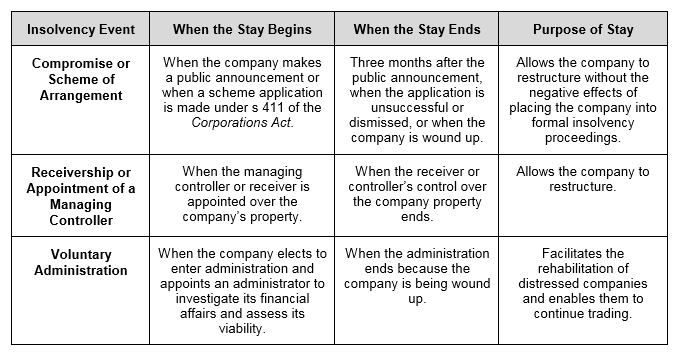McCabes News
New laws affecting ipso facto clauses in contracts came into effect on 1 July 2018. These laws provide a temporary stay on the enforcement of contracts being terminated where a contracting party enters into voluntary administration, receivership or a scheme of arrangement with creditors.
Ipso facto clauses – also known as termination provisions – are found in a wide range of commercial contracts. They create a contractual right that allows one party to elect to terminate or modify the operation of a contract, or for the contract to terminate automatically, upon the occurrence of a specific trigger event.
In the insolvency context, an ipso facto clause is triggered on the occurrence of an ‘insolvency event’, which generally occurs in circumstances where an administrator, liquidator, receiver or controller is appointed. An ipso facto clause will ordinarily be triggered irrespective of whether the party that has suffered the insolvency event is otherwise performing its obligations under the contract.
Ipso facto clauses have long been the subject of debate in Australia. On the one hand, these clauses are said to be beneficial as they provide contracting parties with a right to terminate a contract if another party is at risk of becoming insolvent. On the other hand, ipso facto clauses are also often criticised for reducing the prospects of a successful turnaround of an insolvent (or potentially insolvent) party, and otherwise of negatively impacting the enterprise value of a business that may be entering formal administration.
The Amending Act seeks to stay the enforcement of ipso facto clauses by mandating an automatic ‘stay’ on a party’s right to enforce a provision to terminate or amend a contract (such as through the operation of acceleration clauses) because the counterparty enters into voluntary administration or a scheme of arrangement.
More specifically, the Amending Act operates to stay a contractual right to suspend or terminate the contract arising because:
However, this stay will not prevent parties from terminating in other circumstances, such as a breach of contract arising from non-payment or non-performance.
The Corporations Act has also been amended to allow courts to override the stay if it is satisfied that it is appropriate to do so in the interests of justice.
Importantly, these provisions only apply to contracts entered after 1 July 2018.
The length of the stay will depend on the type of insolvency event that occurs. The following table sets out the various timelines.
 Steven Humphries, Trent Le Breton or Tom Morgan in the McCabes Corporate Team.
Steven Humphries, Trent Le Breton or Tom Morgan in the McCabes Corporate Team.
This article is not legal advice. It is intended to provide commentary and general information only. Access to this article does not entitle you to rely on it as legal advice. You should obtain formal legal advice specific to your own situation. Please contact us if you require advice on matters covered by this article.